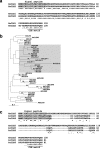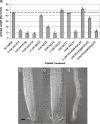Identification of potential host plant mimics of CLAVATA3/ESR (CLE)-like peptides from the plant-parasitic nematode Heterodera schachtii
- PMID: 21199567
- PMCID: PMC6640238
- DOI: 10.1111/j.1364-3703.2010.00660.x
Identification of potential host plant mimics of CLAVATA3/ESR (CLE)-like peptides from the plant-parasitic nematode Heterodera schachtii
Abstract
In this article, we present the cloning of two CLAVATA3/ESR (CLE)-like genes, HsCLE1 and HsCLE2, from the beet cyst nematode Heterodera schachtii, a plant-parasitic cyst nematode with a relatively broad host range that includes the model plant Arabidopsis. CLEs are small secreted peptide ligands that play important roles in plant growth and development. By secreting peptide mimics of plant CLEs, the nematode can developmentally reprogramme root cells for the formation of unique feeding sites within host roots for its own benefit. Both HsCLE1 and HsCLE2 encode small secreted polypeptides with a conserved C-terminal CLE domain sharing highest similarity to Arabidopsis CLEs 1-7. Moreover, HsCLE2 contains a 12-amino-acid CLE motif that is identical to AtCLE5 and AtCLE6. Like all other plant and nematode CLEs identified to date, HsCLEs caused wuschel-like phenotypes when overexpressed in Arabidopsis, and this activity was abolished when the proteins were expressed without the CLE motif. HsCLEs could also function in planta without a signal peptide, highlighting the unique, yet conserved function of nematode CLE variable domains in trafficking CLE peptides for secretion. In a direct comparison of HsCLE2 overexpression phenotypes with those of AtCLE5 and AtCLE6, similar shoot and root phenotypes were observed. Exogenous application of 12-amino-acid synthetic peptides corresponding to the CLE motifs of HsCLEs and AtCLE5/6 suggests that the function of this class of CLEs may be subject to complex endogenous regulation. When seedlings were grown on high concentrations of peptide (10 µm), root growth was suppressed; however, when seedlings were grown on low concentrations of peptide (0.1 µm), root growth was stimulated. Together, these findings indicate that AtCLEs1-7 may be the target peptides mimicked by HsCLEs to promote parasitism.
© 2010 The Authors. Molecular Plant Pathology © 2010 BSPP and Blackwell Publishing Ltd.
Figures



Similar articles
-
Identification of cyst nematode B-type CLE peptides and modulation of the vascular stem cell pathway for feeding cell formation.PLoS Pathog. 2017 Feb 3;13(2):e1006142. doi: 10.1371/journal.ppat.1006142. eCollection 2017 Feb. PLoS Pathog. 2017. PMID: 28158306 Free PMC article.
-
Structural and functional diversity of CLAVATA3/ESR (CLE)-like genes from the potato cyst nematode Globodera rostochiensis.Mol Plant Microbe Interact. 2009 Sep;22(9):1128-42. doi: 10.1094/MPMI-22-9-1128. Mol Plant Microbe Interact. 2009. PMID: 19656047
-
The interaction of the novel 30C02 cyst nematode effector protein with a plant β-1,3-endoglucanase may suppress host defence to promote parasitism.J Exp Bot. 2012 Jun;63(10):3683-95. doi: 10.1093/jxb/ers058. Epub 2012 Mar 21. J Exp Bot. 2012. PMID: 22442414 Free PMC article.
-
Diverse and conserved roles of CLE peptides.Curr Opin Plant Biol. 2008 Feb;11(1):75-81. doi: 10.1016/j.pbi.2007.10.010. Epub 2007 Dec 19. Curr Opin Plant Biol. 2008. PMID: 18078779 Review.
-
CLE signaling systems during plant development and nematode infection.Plant Cell Physiol. 2012 Dec;53(12):1989-99. doi: 10.1093/pcp/pcs136. Epub 2012 Oct 8. Plant Cell Physiol. 2012. PMID: 23045524 Review.
Cited by
-
A novel sugar beet cyst nematode effector 2D01 targets the Arabidopsis HAESA receptor-like kinase.Mol Plant Pathol. 2022 Dec;23(12):1765-1782. doi: 10.1111/mpp.13263. Epub 2022 Sep 7. Mol Plant Pathol. 2022. PMID: 36069343 Free PMC article.
-
Database mining of plant peptide homologues.Plant Biotechnol (Tokyo). 2021 Mar 25;38(1):137-143. doi: 10.5511/plantbiotechnology.20.0720a. Plant Biotechnol (Tokyo). 2021. PMID: 34177333 Free PMC article.
-
Cellular Signaling Pathways and Posttranslational Modifications Mediated by Nematode Effector Proteins.Plant Physiol. 2015 Oct;169(2):1018-26. doi: 10.1104/pp.15.00923. Epub 2015 Aug 27. Plant Physiol. 2015. PMID: 26315856 Free PMC article. Review.
-
The genome of the yellow potato cyst nematode, Globodera rostochiensis, reveals insights into the basis of parasitism and virulence.Genome Biol. 2016 Jun 10;17(1):124. doi: 10.1186/s13059-016-0985-1. Genome Biol. 2016. PMID: 27286965 Free PMC article.
-
Transcriptome analysis in oak uncovers a strong impact of endogenous rhythmic growth on the interaction with plant-parasitic nematodes.BMC Genomics. 2016 Aug 12;17(1):627. doi: 10.1186/s12864-016-2992-8. BMC Genomics. 2016. PMID: 27520023 Free PMC article.
References
-
- Brand, U. , Fletcher, J.C. , Hobe, M. , Meyerowitz, E.M. and Simon, R. (2000) Dependence of stem cell fate in Arabidopsis on a feedback loop regulated by CLV3 activity. Science, 289, 617–619. - PubMed
-
- Casamitjana‐Martinez, E. , Hofhuis, H.F. , Xu, J. , Liu, C.M. , Heidstra, R. and Scheres, B. (2003) Root‐specific CLE19 overexpression and the sol1/2 suppressors implicate a CLV‐like pathway in the control of Arabidopsis root meristem maintenance. Curr. Biol. 13, 1435–1441. - PubMed
-
- Clark, S.E. , Running, M.P. and Meyerowitz, E.M. (1995) CLAVATA3 is a specific regulator of shoot and floral meristem development affecting the same processes as CLAVATA1. Development, 121, 2057–2067.
-
- Clough, S.J. and Bent, A.F. (1998) Floral dip: a simplified method for Agrobacterium‐mediated transformation of Arabidopsis thaliana . Plant J. 16, 735–743. - PubMed
Publication types
MeSH terms
Substances
Associated data
- Actions
- Actions
LinkOut - more resources
Full Text Sources
Other Literature Sources
Molecular Biology Databases
Miscellaneous

